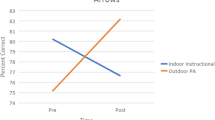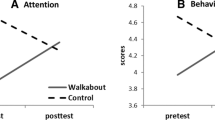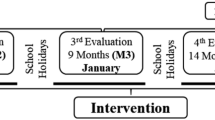Abstract
Physical activity—including outdoor motor play—has been associated with learning and brain-related functions and abilities in elementary school children and adolescence. Few studies have been conducted on the relationships between active play and these cognitive processes in preschool aged children. Several investigations have revealed that adult-directed physical activity can enhance preschoolers’ performance on measures of executive functions, such as inhibitory control or attention. In the present investigation we sought to determine if naturalistic playground play would have a similar effect to adult-guided exercise on a classroom indicator of young children’s cognitive control—on-task behavior during a whole group learning experience. The on-task behavior of 21 three-, four-, and five-year-olds was compared under two conditions—one in which children played outdoors immediately prior to the experience and one in which they did not. Too, the relationship between the level of physical activity on the playground of children and their on-task behavior directly following it was examined. Findings indicate that outdoor play prior to learning resulted in greater on-task behavior for boys and children of low socioeconomic status. Level of activity in play prior to a learning time was positively related to on-task behavior. Implications for scheduling of outdoor play and the role of teachers’ in facilitating more active motor play are discussed. Future research on a larger, more diverse sample of children is recommended.
Similar content being viewed by others
References
Alin, A. (2010). Multicollinearity. Wiley Interdisciplinary Reviews: Computational Statistics, 2, 370–374.
Bartholomew, J. B., Golaszewski, N. M., Jowers, E., Korinek, E., Roberts, G., Fall, A., et al. (2018). Active learning improves on-task behaviors in 4th grade children. Preventive Medicine, 111, 49–54.
Becker, D. R., Grist, C. L., Caudle, L. A., & Watson, M. K. (2018). Complex physical activities, outdoor play, and school readiness among preschoolers. Global Education Review, 5(2), 110–122.
Becker, D. R., McClelland, M. M., Loprinzi, P., & Trost, S. G. (2014). Physical activity, self-regulation, and early academic achievement in preschool children. Early Education & Development, 25(1), 56–70.
Best, J. R. (2010). Effects of physical activity on children’s executive function: Contributions of experimental research on aerobic exercise. Developmental Review, 30(4), 331–351.
Bidzan-Bluma, I., & Lipowska, M. (2018). Physical activity and cognitive functioning of children: A systematic review. International Journal of Environmental Research and Public Health, 15(4), 800. https://doi.org/10.3390/ijerph15040800.
Brown, W. H., Pfeiffer, K. A., McIver, K. L., Dowda, M., Almeida, J. M., & Pate, R. R. (2006). Assessing preschool children's physical activity: The Observational System for Recording Physical Activity in children-preschool version. Research Quarterly for Exercise and Sport, 77(2), 167–176.
Caldas, S. J., & Reilly, M. S. (2018). The influence of race–ethnicity and physical activity levels on elementary school achievement. The Journal of Educational Research, 111, 473–486.
Centers for Disease Control and Prevention. (2018). Physical activity guidelines for Americans, 2nd edition. Retrieved November 15, 2019, from https://www.cdc.gov/physicalactivity/everyone/guidelines/children.html.
Chaddock, L., Erickson, K. I., Prakash, R. S., VanPatter, M., Voss, M. W., & Pontifex, M. B. (2010). Basaet al.l ganglia volume is associated with aerobic fitness in preadolescent children. Developmental Neuroscience, 32(3), 249–256.
Chaddock, L., Pontifex, M. B., Hillman, C. H., & Kramer, A. F. (2011). A review of the relation of aerobic fitness and physical activity to brain structure and function in children. Journal of the International Neuropsychological Society, 17(6), 975–985.
Chaddock-Heyman, L., Erickson, K. I., Voss, M., Knecht, A., Pontifex, M. B., Castelli, D., et al. (2013). The effects of physical activity on functional MRI activation associated with cognitive control in children: A randomized controlled intervention. Frontiers in Human Neuroscience, 7, 72.
Chen, A. G., Yan, J., Yin, H. C., Pan, C. Y., & Chang, Y. K. (2014). Effects of acute aerobic exercise on multiple aspects of executive function in preadolescent children. Psychology of Sport and Exercise, 15(6), 627–636.
Chen, A. G., Zhu, L. N., Yan, J., & Yin, H. C. (2016). Neural basis of working memory enhancement after acute aerobic exercise: fMRI study of preadolescent children. Frontiers in Psychology. https://doi.org/10.3389/fpsyg.2016.01804.
Coe, D. P. (2018). Means of optimizing physical activity in the preschool environment. American Journal of Lifestyle Medicine, 14, 16–23.
Culpepper, D., & Killion, L. (2018). Physical activity in pre-school children: Role of the teacher during free play. Journal of Sports Science, 6, 144–148.
Davis, C. L., Tomporowski, P. D., McDowell, J. E., Austin, B. P., Miller, P. H., Yanasak, N. E., et al. (2011). Exercise improves executive function and achievement and alters brain activation in overweight children: A randomized, controlled trial. Health Psychology, 30(1), 91.
Daly, M., & Corcoran, R. P. (2019). Kindergarten self-control mediates the gender reading achievement gap: A population-based cohort study. Journal of Research in Personality. https://doi.org/10.1016/j.jrp.2019.103881.
DiPrete, T. A., & Jennings, J. L. (2012). Social and behavioral skills and the gender gap in early educational achievement. Social Science Research, 41(1), 1–15.
Driediger, M., Truelove, S., Johnson, A. M., Vanderloo, L. M., Timmons, B. W., Burke, S. M., et al. (2019). The impact of shorter, more frequent outdoor play periods on preschoolers’ physical activity during childcare: A cluster randomized controlled trial. International Journal of Environmental Research and Public Health, 16(21), 4126. https://doi.org/10.3390/ijerph16214126.
Drollette, E. S., Scudder, M. R., Raine, L. B., Moore, R. D., Saliba, B. J., Pontifex, M. B., et al. (2014). Acute exercise facilitates brain function and cognition in children who need it most: An ERP study of individual differences in inhibitory control capacity. Developmental Cognitive Neuroscience, 7, 53–64.
Egger, F., Benzing, V., Conzelmann, A., & Schmidt, M. (2019). Boost your brain, while having a break! The effects of long-term cognitively engaging physical activity breaks on children’s executive functions and academic achievement. PLoS ONE. https://doi.org/10.1371/journal.pone.0212482.
Erwin, H. (2017). Multiple recess periods per day: Creatively scheduling instructional time. Journal of Physical Education, Recreation & Dance, 88, 3–4.
Esteban-Cornejo, I., Cadenas-Sanchez, C., & Contreras-Rodriguez, O. (2017). In: Verdejo-Roman, J., Mora-Gonzalez, J, & Migueles, J.H., (Eds) A whole brain volumetric approach in overweight/obese children: Examining the association with different physical fitness components and academic performance. Neuroimage, 159, 346–354.
Fan, X., & Cao, Z. B. (2017). Physical activity among Chinese school-aged children: National prevalence estimates from the 2016 Physical Activity and Fitness in China—The Youth Study. Journal of Sport and Health Science, 6(4), 388–394.
Fedewa, A. L., Ahn, S., Erwin, H., & Davis, M. C. (2015). A randomized controlled design investigating the effects of classroom-based physical activity on children’s fluid intelligence and achievement. School Psychology International, 36(2), 135–153.
Ferris, L. T., Williams, J. S., & Shen, C. L. (2007). The effect of acute exercise on serum brain-derived neurotrophic factor levels and cognitive function. Medicine & Science in Sports & Exercise, 39(4), 728–734.
Figlio, D., Karbownik, K., Roth, J., & Wasserman, M. (2019). Family disadvantage and the gender gap in behavioral and educational outcomes. American Economic Journal: Applied Economics, 11(3), 338–381.
Figueroa, R., & An, R. (2017). Motor skill competence and physical activity in preschoolers: A review. Maternal and Child Health Journal, 21(1), 136–146.
Funtikova, A. N., Navarro, E., Bawaked, R. A., Fíto, M., & Schröder, H. (2015). Impact of diet on cardiometabolic health in children and adolescents. Nutrition Journal, 14(1), 118.
Gapin, J. I., Labban, J. D., & Etnier, J. L. (2011). The effects of physical activity on attention deficit hyperactivity disorder symptoms: The evidence. Preventive Medicine, 52, S70–S74.
Godwin, K. E., Almeda, M. V., Seltman, H., Kai, S., Skerbetz, M. D., Baker, R. S., et al. (2016). Off-task behavior in elementary school children. Learning and Instruction, 44, 128–143.
Grieco, L. A., Jowers, E. M., Errisuriz, V. L., & Bartholomew, J. B. (2016). Physically active vs sedentary academic lessons: A dose response study for elementary student time on-task. Preventive Medicine, 89, 98–103.
Gubbels, J. S., Van Kann, D. H., & Jansen, M. W. (2012). Play equipment, physical activity opportunities, and children's activity levels at childcare. Journal of Environmental and Public Health. https://doi.org/10.1155/2012/32652.
Halliday, S. E., Calkins, S. D., & Leerkes, E. M. (2018). Measuring preschool learning engagement in the laboratory. Journal of Experimental Child Psychology, 167, 93–116.
Hanushek, E. A., Peterson, P. E., Talpey, L. M., & Woessmann, L. (2020). Long-run trends in the U.S. SES-achievement gap. Bonn, Germany: National Bureau of Economic Research.
Hesketh, K. R., Lakshman, R., & van Sluijs, E. M. F. (2017). Barriers and facilitators to young children's physical activity and sedentary behaviour: A systematic review and synthesis of qualitative literature. Obesity Reviews, 18(9), 987–1017.
Hillman, C. H., & Pontifex, M. B. (2009). The effect of acute treadmill walking on cognitive control and academic achievement in preadolescent children. Neuroscience, 159(3), 1044–1054.
Hillman, C. H., Pontifex, M. B., Raine, L. B., Castelli, D. M., Hall, E. E., & Kramer, A. F. (2009a). The effect of acute treadmill walking on cognitive control and academic achievement in preadolescent children. Neuroscience, 159(3), 1044–1054.
Hillman, C. H., Buck, S. M., Themanson, J. R., Pontifex, M. B., & Castelli, D. M. (2009b). Aerobic fitness and cognitive development: Event-related brain potential and task performance indices of executive control in preadolescent children. Developmental Psychology, 45(1), 114.
Holmes, R. M., Pellegrini, A. D., & Schmidt, S. L. (2006). The effects of different recess timing regimens on preschoolers' classroom attention. Early Child Development and Care, 176(7), 735–743.
Howie, E. K., Beets, M. W., & Pate, R. R. (2014). Acute classroom exercise breaks improve on-task behavior in 4th and 5th grade students: A dose–response. Mental Health and Physical Activity, 7(2), 65–71.
Hutton, J. S., Dudley, J., Horowitz-Kraus, T., DeWitt, T., & Holland, S. K. (2019). Associations between home literacy environment, brain white matter integrity and cognitive abilities in preschool-age children. Acta Paediatrica. https://doi.org/10.1111/apa.15124.
Jäger, K., Schmidt, M., Conzelmann, A., & Roebers, C. M. (2014). Cognitive and physiological effects of an acute physical activity intervention in elementary school children. Frontiers in Psychology, 5, 1473. https://doi.org/10.3389/fpsyg.2014.01473.
John, A. M. S., Kibbe, M., & Tarullo, A. R. (2019). A systematic assessment of socioeconomic status and executive functioning in early childhood. Journal of Experimental Child Psychology, 178, 352–368.
Ketcheson, L., Hauck, J. L., & Ulrich, D. (2018). The levels of physical activity and motor skills in young children with and without autism spectrum disorder, aged 2–5 years. Autism, 22(4), 414–423.
Khan, N. A., & Hillman, C. H. (2014). The relation of childhood physical activity and aerobic fitness to brain function and cognition: A review. Pediatric Exercise Science, 26(2), 138–146.
Krafft, C. E., Schwarz, N. F., Chi, L., Weinberger, A. L., Schaeffer, D. J., Pierce, J. E., et al. (2014). An 8-month randomized controlled exercise trial alters brain activation during cognitive tasks in overweight children. Obesity, 22(1), 232–242.
Lan, X., Legare, C. H., Ponitz, C. C., Li, S., & Morrison, F. J. (2011). Investigating the links between the subcomponents of executive function and academic achievement: A cross-cultural analysis of Chinese and American preschoolers. Journal of Experimental Child Psychology, 108(3), 677–692.
Last, B. S., Lawson, G. M., Breiner, K., Steinberg, L., & Farah, M. J. (2018). Childhood socioeconomic status and executive function in childhood and beyond. PLoS ONE. https://doi.org/10.1371/journal.pone.0202964.
Legewie, J., & DiPrete, T. A. (2012). School context and the gender gap in educational achievement. American Sociological Review, 77(3), 463–485.
Luke, S., Vail, C. O., & Ayres, K. M. (2014). Using antecedent physical activity to increase on-task behavior in young children. Exceptional Children, 80(4), 489–503.
Määttä, S., Gubbels, J., Ray, C., Koivusilta, L., Nislin, M., Sajaniemi, N., et al. (2019). Children’s physical activity and the preschool physical environment: The moderating role of gender. Early Childhood Research Quarterly, 47, 39–48.
Mahar, M. T., Murphy, S. K., Rowe, D. A., Golden, J., Shields, A. T., & Raedeke, T. D. (2006). Effects of a classroom-based program on physical activity and on-task behavior. Medicine & Science in Sports & Exercise, 38(12), 2086–2094.
Mahoney, K., & Fagerstrom, T. (2006). Give me a break! Can strategic recess scheduling increase on-task behaviour for first graders. Ontario Act Res, 9(2), 1–6.
Matthews, J. S., Marulis, L. M., & Williford, A. P. (2014). Gender processes in school functioning and the mediating role of cognitive self-regulation. Journal of Applied Developmental Psychology, 35(3), 128–137.
Mileva-Seitz, V. R., Ghassabian, A., Bakermans-Kranenburg, M. J., van den Brink, J. D., Linting, M., Jaddoe, V. W., et al. (2015). Are boys more sensitive to sensitivity? Parenting and executive function in preschoolers. Journal of Experimental Child Psychology, 130, 193–208.
Miramontez, S. K., & Schwartz, I. S. (2017). The effects of physical activity on the on-task behavior of young children with autism spectrum disorders. International Electronic Journal of Elementary Education, 9(2), 405–418.
Moffett, L., & Morrison, F. J. (2019). Off-task behavior in kindergarten: Relations to executive function and academic achievement. Journal of Educational Psychology. https://doi.org/10.1037/edu0000397.
Montroy, J. J., Bowles, R. P., Skibbe, L. E., McClelland, M. M., & Morrison, F. J. (2016). The development of self-regulation across early childhood. Developmental Psychology, 52(11), 1744.
Ortega, F. B., Campos, D., Cadenas-Sanchez, C., Altmäe, S., Martínez-Zaldívar, C., Martín-Matillas, M., et al. (2017). Physical fitness and shapes of subcortical brain structures in children. British Journal of Nutrition, 122(s1), S49–S58.
Owens, J. (2016). Early childhood behavior problems and the gender gap in educational attainment in the United States. Sociology of Education, 89(3), 236–258.
Palmer, K. K., Miller, M. W., & Robinson, L. E. (2013). Acute exercise enhances preschoolers’ ability to sustain attention. Journal of Sport and Exercise Psychology, 35(4), 433–437.
Simmonds, M., Llewellyn, A., Owen, C. G., & Woolacott, N. (2016). Predicting adult obesity from childhood obesity: A systematic review and meta-analysis. Obesity Reviews, 17(2), 95–107.
Stein, M., Auerswald, M., & Ebersbach, M. (2017). Relationships between motor and executive functions and the effect of an acute coordinative intervention on executive functions in kindergartners. Frontiers in Psychology, 8, 859. https://doi.org/10.3389/fpsyg.2017.00859.
Sugiyama, T., Okely, A. D., Masters, J. M., & Moore, G. T. (2012). Attributes of child care centers and outdoor play areas associated with preschoolers’ physical activity and sedentary behavior. Environment and Behavior, 44(3), 334–349.
Tortella, P., Haga, M., Ingebrigtsen, J. E., Sigmundsson, H., & Fumagalli, G. F. (2019). Comparing free play and partly structured play in 4–5-years-old children in an outdoor playground. Frontiers in Public Health. https://doi.org/10.3389/fpubh.2019.00197.
Tottori, N., Morita, N., Ueta, K., & Fujita, S. (2019). Effects of high intensity interval training on executive function in children aged 8–12 years. International Journal of Environmental Research and Public Health, 16(21), 4127.
Truelove, S., Vanderloo, L. M., & Tucker, P. (2017). Defining and measuring active play among young children: A systematic review. Journal of Physical Activity and Health, 14(2), 155–166.
Tucker, P., Vanderloo, L. M., Johnson, A. M., Burke, S. M., Irwin, J. D., Gaston, A., et al. (2017). Impact of the supporting physical activity in the childcare environment (SPACE) intervention on preschoolers’ physical activity levels and sedentary time. International Journal of Behavioral Nutrition and Physical Activity, 14(1), 120. https://doi.org/10.1186/s12966-017-0579-7.
U.S. Department of Health and Human Services. (2017). Revised federal policy for the protection of human subjects (the Common Rule). Retrieved November 15, 2019, from: https://www.hhs.gov/ohrp/regulations-and-policy/regulations/finalized-revisions-common-rule/index.html.
Vale, S., Trost, S. G., Rêgo, C., Abreu, S., & Mota, J. (2015). Physical activity, obesity status, and blood pressure in preschool children. The Journal of Pediatrics, 167(1), 98–102.
Vrantsidis, D. M., Clark, C. A., Chevalier, N., Espy, K. A., & Wiebe, S. A. (2019). Socioeconomic status and executive function in early childhood: Exploring proximal mechanisms. Developmental Science. https://doi.org/10.1111/desc.2917.
Wadsworth, D. D., Johnson, J. L., Carroll, A. V., Pangelinan, M. M., Rudisill, M. E., & Sassi, J. (2020). Intervention strategies to elicit MVPA in preschoolers during outdoor play. International Journal of Environmental Research and Public Health, 17(2), 650.
Webster, E. K., Wadsworth, D. D., & Robinson, L. E. (2015). Preschoolers’ time on-task and physical activity during a classroom activity break. Pediatric Exercise Science, 27(1), 160–167.
Whipple, S. S., Genero, C. K., & Evans, G. W. (2016). Task persistence: A potential Mediator of the income-achievement gap. Journal of Applied Research on Children, 7(1), 4.
Author information
Authors and Affiliations
Corresponding author
Additional information
Publisher's Note
Springer Nature remains neutral with regard to jurisdictional claims in published maps and institutional affiliations.
Rights and permissions
About this article
Cite this article
Lundy, A., Trawick-Smith, J. Effects of Active Outdoor Play on Preschool Children’s on-Task Classroom Behavior. Early Childhood Educ J 49, 463–471 (2021). https://doi.org/10.1007/s10643-020-01086-w
Published:
Issue Date:
DOI: https://doi.org/10.1007/s10643-020-01086-w




